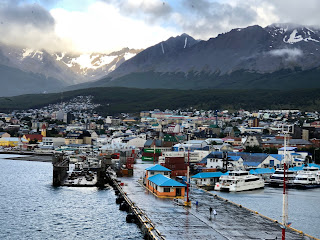The ship entered the port of Ushaia at 10:30 p.m. The sunset and the twinkling of the city
lights nestled into the mountains made a great photo.
The next morning as I ate breakfast I captured some
beautiful photographs of this quaint little town. Fishing boats and small barges were docked
throughout. There were homes and
businesses of various colors. The blues, yellows & reds offered a palette
of color.
It wasn’t time to go ashore, so Kenny and I walked around
the ship to see all sides of Ushaia. As
I turned a corner, I captured a rainbow on the port side. I knew that it was going to be a beautiful
day.
We boarded the bus for our half-day tour of Ushaia. Our guide, Anna, was a young lady in her 20’s. Her parents were doctors who had left Buenos
Aires thirty years ago to settle in this community. Forty years ago the population was about
5,000 and today it is 70,000. Anna said
that she loved Ushaia, but the one thing missing is the older generation, there
are no grandparents. Sixty percent of
the population is under the age of 18.
Ushaia is known as the southernmost city in the world and is
the capital of the Tierra del Fuego province, which includes the Argentine
arctic islands and the Islas Malvinas.
It is nicknamed the “End of the World”.
As picturesque as Ushaia is, it was known as the “Siberia of
Argentina”. A penal colony was set up
in 1896. The early city’s buildings and
infrastructure, including the railway were built by forced convict labor. The prison closed in 1947.
The main economy is lumber, sheep, fishing, trapping and
tourism.
On our tour, we would visit the Pipo River Valley in the
Tierra del Fuego National Park; Ensenada Bay overlooking Beagle Channel; Roca
Lake and Lapataia Bay (which is the last stop on the Pan-American Highway that
begins in Alaska and stretches nearly 12,000 miles are two continents.
When we arrived at Lapataia Bay, there were other busses
with tourists there as well to see this beautiful area. This bay was formed by the glacier forces
that shaped the entire area.
Many individuals were hiking through this area, which winds
through stunning coastal scenery and offers an opportunity to see wildlife,
such as dolphins, otters, ducks, etc. Of
course, Kenny and I had our picture taken with the sign for Tierra del Fuego
National Park.
Off to the visitor center, we took a coffee break. While we were waiting for everyone to get on
the bus, Kenny and I walked down to the lake and in the distance we could hear
a bird quacking. It was a male, White
Fronted Goose. A few yards to the right,
we could see a dark head bobbing in the grass.
It was the female and she had seven goslings. All at once, the male wobbled over to the
female and their young and they moved away from the lake. With the female in the lead, the seven goslings
followed in a line and the male brought up the rear. They moved through the tall grass, across a
gravel road and then up the hill to the Visitor Center. It was as if they wanted to show off their
family to the tourists.
Ensenada Bay overlooks the Beagle Channel. This is named
after the ship that carried English naturalist, Charles Darwin. This is also where the Post Office at the
“End of the World” is located. Another
great photo shot is with the sign showing different distances from the “End of
the World”: Buenos Aires, the Arctic, Antarctica, Paris, New York, etc.
Last stop was Roca Lake.
One third of this lake is Argentinian territory and the remaining
portion is the territory of Chile. When
we got off the bus to take photos it was sunny and warm and within seconds, the
wind began to blow and it became overcast and the temperature dropped. We didn’t stay long.

No comments:
Post a Comment